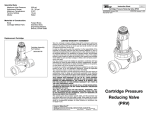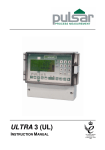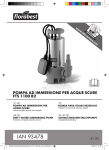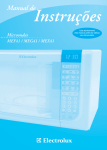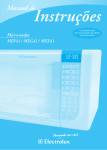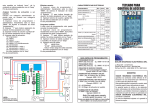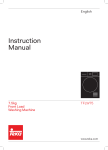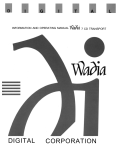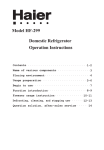Download 42712-0400 AtomicSolarWatch USA
Transcript
JUNGHANS UHREN GmbH · P. O. Box 100 · D-78701 Schramberg www.junghanswatches.com 42.712-0400/0602 Atomic solar watch Reloj atómico solar Instruction Manual Manual de instrucciones Junghans. Time moves us. 1. Technology description The most accurate clock in America is the atomic caesium clock located at: U.S. Department of Commerce National Institute of Standards and Technology (NIST) Boulder, Colorado Your Junghans atomic watch receives ”time telegrams” on long wave radio (60 kHz) from the NIST operated WWVB time signal transmitter located in Fort Collins, Colorado and coupled with the atomic caesium clock in Boulder. Until recently, the transmitter was used predominantly by telephone companies, radio and television stations, navigators of planes and ships, and for scientific purposes in laboratories. Now this precise signal can be received by the Junghans atomic watch technology. 2 Your Junghans atomic watch receives the WWVB time signal via its built-in antenna system. The proper function of the receiver contained in this product has been tested as a prototype with regard to its sensitivity and range of reception in different places throughout the United States. Any claim for warranty – express or implied – due to the watch's failure to properly receive the radio signal because of interference, whatever may be the source of this interference, are hereby expressly excluded in all respects. For more information about the WWVB-Radio signal visit NIST’s website at: www.boulder.nist.gov For actual signal coverage in North America visit: www.boulder.nist.gov/timefreq/stations/wwvbcoverage.htm The Junghans atomic watch's internal computer processes the received time signals and automatically synchronizes the hands, date and the change over between daylight saving time and standard time and the leap year accordingly. The signal reception and synchronization occurs automatically every night and manually upon demand. Even outside of the reception range your Junghans atomic watch will continue to keep excellent time. The highly accurate 32 kHz quartz movement will ensure precise time keeping. Your Junghans solar-powered atomic watch is equipped with the latest solar technology. It runs with solar energy (the solar cell is integrated in the dial), using the internal energy storage to build up a power reserve. If fully charged this power reserve is sufficient for up to 4 months. 3 Even in complete darkness (e. g. in case you leave your watch in a drawer for some days) the watch keeps working as precisely as always. Nevertheless try to place your watch in a bright place when not wearing it in order to ensure proper function at any time. For the optimal use of your Junghans solar-powered atomic watch please take care that your watch is charged at all times. Please be aware of the fact that in cases your watch is covered e. g. by long sleeves it might become insufficiently charged. For more details on solar technology please also see 5. Information concerning solar-powered watches. For technical questions please contact our customer service center Providence watch hospital inc 1024 Reservoir Ave. Cranston, RI 02910 Phone 401-944-5100 Fax 401-944-6344 Email [email protected] 4 2. Functional description Fig. 2 T1 button (mode): The T1 button has two functions: 1) Switches the digital display between date (for example 12.19) and time zone (for example, P02 PM ). The letter P,M,C or E in front of the digitally displayed hour shows the respective U.S time zone Pacific, Mountain, Central, or Eastern. 2) Receives the WWVB time signal and synchronizes the time manually. 5 T2 button (adjust): Depending on the mode the T2 button either 1) Advances the hands when manually synchronizing the watch after complete exhaustion of the power reserve. 2) Advances the hands in 1 hour increments when setting the time zones. 3. Manual synchronisation The automatic signal reception and synchronization occurs automatically every night. At any desired time you can perform a "manual" reception by pressing the T1 button for at least 3 seconds. The hands will set to the 12 o'clock position during reception and will reset themselves thereafter. Note that your Junghans atomic watch will only receive the WWVB time signal if set to one of the following time zones: Pacific, Mountain, Central or Eastern standard time. In case your watch’s energy store is exhausted and you recharge the watch, it will automatically set itself to Pacific standard time within the following 30 minutes. (If a time zone other than Pacific is required, it can be set subsequently as described in chapter 4. Setting the time zone). Please note: This automatic synchronization does not work, when the watch is located outside the transmitter’s range or in a disturbance field caused by climatic conditions, electric devices etc. Under these circumstances having recharged the power reserve sufficiently the watch will display its own time starting at 12:00 and start further attempts to synchronize itself every hour. In case the watch does not succeed in synchronizing itself, there are two possibilities to set the 6 correct time: Inside the range of the transmitter: Place your watch in a free field, a place free of radio disturbances such as electric appliances, metal structures or particular climatic conditions, and start a ”manual“ reception by pressing the T1 button for at least 3 seconds. The hands will run to the 12 o’clock position for reception and will set themselves to the correct time after a few minutes. Outside the range of the transmitter: The time can be set manually by advancing the hands with the T2 button. Pressing T2 briefly advances the minute hand one minute, holding the button down lets the minute hand move continuously until the T2 button is released. (The minute is also shown in the LCD helping you to set the correct time.) Your watch now uses its integrated quartz movement. Please note: in this mode your watch cannot display the date. The time you have set is retained until your watch is able to receive the signal from the transmitter again. The date will then also be reset and displayed in the LCD again. 4. Setting the time zone The time preset by the factory might not be the correct time for the time zone you are in. To set the correct time please proceed as follows: 1) Press the T2 button. The digital display will change from displaying the date (for example, 12.19) to displaying the current hour (for example, P02 PM ). The letter P, M, C or E in front of the digitally displayed hour stands for Pacific, Mountain, Central and Eastern standard time respectively. If no letter is displayed in front of the hour a different time zone has been set. 7 2) Press (either short for incremental advance or long for rapid advance) the T2 button to set the desired hour for your time zone. Please take note of the AM/PM symbols in the digital display. The proper date will be calculated by the internal microprocessor. And at the end of the adjustment the display returns to the default value, showing the date. 5.2 Charging times for solar watches The charging times for your atomic solar watch depend on the intensity of the light source. The times given in the table below serve as a reference. Please note that, to avoid damaging your watch, you must not expose it to temperatures below 32°F or above 122°F while recharging it. 5. Information concerning solar-powered watches 5.1 Charge level indicator for atomic solar watches Solar watches are fully charged at the factory, so they have a power reserve sufficient for approx. 4 months. The LC display indicates when your solar watch requires solar energy. Solar watches with analog 3-handed display No display: The energy store is exhausted and your watch has switched off. When light reaches the dial, your watch will start up. Your watch is already charging but is not yet functional. Please continue to expose the dial to light. Lo 12.19. 8 If the voltage in the energy store is too low, the display alternates between the currently set mode (e. g. date) and ”Lo“ and the second hand remains on the 12 o‘clock position. Please expose the watch dial to a light source. The date is displayed. Your watch is fully functional. Take special care if you expose your Display watch to direct sunlight when you Light are not wearing it. The temperature intensity Empty in the watch may rise above the permitted maximum of 122°F. –– Light source From Y until energy –– Y From Y store is fully to Y to P02PM charged Ambient conditions Daily light requirement for continuous operation Daylight Cloudless sunshine 40 klx 10 min. 1h 12 h 5 min. Daylight cloudy 10 klx 30 min. 2h 2 days 15 min. Neon light 40 W 40 cm distance 5 klx 1h 4h 4 days 30 min. Light bulb 60 W 40 cm distance 1 klx 5h 1 day 17 days 2.5 h Important: For atomic solar watches with printed solar cells, the charging times given in the table must be doubled. 9 5.3 General information ● Charging times may vary slightly from watch to watch. We recommend charging your solar wristwatch a little each day to avoid the energy store running down completely. ● Normal daylight is sufficient for continuous operation of your solar wristwatch. Avoid covering the dial completely with your sleeve, as otherwise no light can reach it. ● When the energy store is fully charged, your solar wristwatch will run for up to 4 months even in darkness. ● When you are not wearing your solar wristwatch, you should keep it in a light place, preferably exposed to room lighting e. g. in a glass cabinet. This will ensure that your watch is always ready for use. ● If you keep your watch in darkness for a long period, it will switch off automatically when the power reserve has been used up. It then requires recharging. 6. Technical data Reception frequency Quartz time base Power reserve Operating temperature 10 60 kHz, amplitude modulated, WWVB coding 32 kHz approx. 4 months (fully charged) 0°C to 50°C / 32°F to 122°F 6.1 Adjusting the leather wrist strap Depending on the particular model, the wriststrap of your watch may be fitted with a folding clasp. To adjust the length of the wriststrap to suit your wrist, proceed as follows: Open the hinged clasp of the fastening q. You can now adjust the leather strap to the required length. Once adjusted, close the hinged clasp w. Please ensure that the pin of the hinged clasp fits precisely back into the hole of the leather strap. 1 2 6.2 Adjusting the ceramic/stainless steel wrist strap Please refer to your specialist watch shop. 11 The ”water-resistant” state only applies in new condition. External influences may, however, affect water resistance. 7. General information x Servicing, such as repairs to the glass, seal or wriststrap, should only be carried out by a specialist watch retailer. x Please have the seals and glass inspected by an expert at regular intervals, approx. every 2 years. x If condensation gets into your watch, have it inspected by the Customer Service Unit without delay. Penetration of moisture may damage the watch. x Your watch is fitted with a quality wriststrap which has undergone multiple inspections at our factory. If, however, you decide to change the wriststrap, please fit a new one of the same quality, preferably an original Junghans wriststrap. x Clean your watch and wriststrap with a dry or slightly moist, soft cloth. Caution: Do not use chemical cleaners (e.g. benzine or paint thinners), as these may harm the surface. x Important: If your watch has a ceramic bracelet, do not clean it with benzine, benzole or gasolene. Only use water and detergent, or water with isopropyl alcohol mixed 60% to 40%. Please have your watch checked regularly. Service for your Junghans atomic solar watches 6.3 Water resistance Designation Case back * waterresistant to 3 bar waterresistant to 5 bar * Instruction for use Dial * * * Washing, rain, splashes In the shower In the bath Swimming Diving without gear no no no no no yes no no no no yes no yes no no no designation In case your watch requires service, please send it in its original box to: PWH · Attn: Service Departement I024 Reservoir Ave. · Cranston, RI 029I0 Phone: I-40I-944-5I00 12 13 8. Warranty 8.1 Limited Warranty This Junghans product is warranted by Junghans to the customer for a period of one (1) year from the date of original purchase ("warranty period") against defects in material and workmanship. If such a defect occurs during the warranty period Junghans will – at its option – repair or replace the product provided that proof of date and place of purchase is supplied by the customer. This limited warranty does not cover bracelets, straps, glasses, or wear to the case nor does it apply in case of misuse or abuse including defects caused by servicing not performed by an authorized Junghans SERVICE CENTER. 8.2 Exclusion of Warranty The proper functioning of the receiver contained in this product has been tested as a prototype with regard to its sensitivity and range of reception in different places throughout the United States. Any claims for warranty – express or implied – due to the clock's failure to properly receive radio signals because of interference whatever may be the source of that interference are hereby expressly excluded in all respects. 14 15 9. Trouble shooting 1) 2) 3) Symptom No date The display shows ”LO ”. The second hand remains at the 12 o’clock position. Your watch does not automatically change between daylight saving time and standard time. 4) The hands do not move and digital display is blank. 5) The second hand remains stationary at the 15 second position for several minutes. Description The time has been set manually and the watch has not yet received WWVB time signal (see 3. Manual synchronisation). Cause You may be out of the reception range. You may be in or near a disturbance field such as a metal structure, appliances or particular climatic conditions. The voltage in the energy store is too low. The watch has not received the WWVB time signal. You may be out of the reception range. You may be in or near a disturbance field such as a metal structure, appliances or particular climatic conditions. The energy store is exhausted and your watch has switched off. Solution If you find yourself within the reception range, press the T1 button for at least 3 seconds and place your watch in a free field* position for a few minutes, preferably at night when reception is best. Press the T1 button and place your watch in a free field* position for a few minutes, preferably at night when reception is best. The watch dial has to be exposed to a light source (see Section 5). Press the T1 button for at least 3 seconds after reentering the reception range to set the correct time. Press the T1 button for at least 3 seconds and place your watch in a free field* position for a few minutes, preferably at night when reception is best. The watch has to be recharged by exposing the dial to a source of light. (also confer table with charging times) This is a normal state during signal reception and is necessary for optimal reception. *Free field position means a place free of radio disturbances such as electrical appliances, metal structures and particular climatic conditions. This product complies with the EMC directives of the European Union and 16 is subject to technical changes without notice. For more information on Junghans and atomic solar watch technology see our internet site at www.junghanswatches.com 17 1. Descripción de la tecnología empleada El reloj más preciso de América es el reloj atómico de cesio que se encuentra en el: Ministerio de Comercio de Estados Unidos National Institute of Standards and Technology (NIST) Boulder, Colorado Su reloj atómico Junghans recibe "informaciones horarias" a una frecuencia de onda larga de 60 kHz del transmisor de señales horarias por la WWVB del NIST situado en Fort Collins, Colorado, que a su vez está conectado al reloj atómico de cesio de Boulder. Hasta hace poco, el transmisor lo utilizaban básicamente las compañías telefónicas, las emisoras de radio y televisión, pilotos de avión y capitanes de barco, y también se empleaba para fines científicos en laboratorios. Ahora esta precisa señal puede ser recibida por la tecnología del reloj atómico de Junghans. 18 Su reloj atómico Junghans recibe señales horarias por la WWVB a través de un sistema de antena incorporado. El alcance y la sensibilidad del receptor que incorpora este producto se han comprobado a través de pruebas realizadas sobre un prototipo en distintos lugares de Estados Unidos. No se aceptarán reclamaciones bajo ningún concepto – ni explícitas ni implícitas - por fallos en la recepción de la señal provocados por interferencias, independientemente de la fuente de la que procedan. Para obtener más información acerca de la señal WWVB visite la página web de NIST: www.boulder.nist.gov Para obtener más información acerca de la cobertura en Norteamérica consulte: www.boulder.nist.gov/timefreq/stations/wwvbcoverage.htm El ordenador interno del reloj atómico Junghans procesa las señales horarias recibidas y sincroniza automáticamente las manecillas, la fecha, el cambio de horario de invierno y verano y el año bisiesto, en su caso. La recepción de la señal y la sincronización se produce automáticamente cada noche y manualmente cuando lo solicite. El reloj atómico Junghans seguirá marcando la hora con exactitud aunque esté fuera del alcance de la señal. La precisión del mecanismo de cuarzo de 32 kHz garantiza la exactitud de la hora que marca el reloj. Su reloj atómico solar Junghans está equipado con la tecnología solar más avanzada. Funciona con energía solar ( el panel solar está integrado en la esfera), y utiliza un sistema de almacenamiento interno de energía para crear una reserva de ésta. Cuando está completamente cargada, esta reserva de energía es suficiente para cuatro meses. 19 Incluso en completa oscuridad ( p.e. si deja su reloj en un cajón durante unos días ) el reloj continúa funcionando con la misma precisión de siempre. De cualquier forma, intente dejar su reloj en un lugar iluminado cuando no lo lleve puesto con el fin de asegurar su correcto funcionamiento en cualquier circunstancia. Para un uso optimizado de su reloj atómico solar Junghans, por favor cuide de que su reloj esté cargado en todo momento. Tenga en cuenta el hecho de que en el caso de que su reloj esté cubierto ( p.e.por mangas largas ) puede ser que no carge suficientemente. Para mayor información sobre la tecnología solar, consulte por favor el punto 5. Información relativa a relojes solares. 2. Funcionamiento Para cuestiones técnicas, contacte por favor con nuestro servicio de atención al cliente Fig. 2 Providence watch hospital inc 1024 Reservoir Ave. Cranston, RI 02910 Phone 401-944-5100 Fax 401-944-6344 Email [email protected] 20 Botón T1 (modo): El botón T1 tiene dos funciones: 1) Cambia la pantalla digital para mostrar la fecha (por ejemplo, 12.19) o la zona horaria (por ejemplo, P02 PM ). La letra P, M, C o E delante de la hora indica las distintas zonas horarias de los Estados Unidos: Pacífico, Montaña, Central, o Este. 2) Recibe las señales horarias por la WWVB y sincroniza la hora manualmente. Botón T2 (ajuste): Dependiendo del modo, el botón T2 puede: 1) Adelantar las manecillas cuando se ajusta el reloj manualmente después de que se haya agotado completamente la reserva de energía. 21 2) Adelantar las manecillas en incrementos de 1 hora al determinar las zonas horarias. 3. Sincronización manual La recepción automática de la señal y la sincronización se producen automáticamente todas las noches. Cuando lo desee puede realizar una recepción "manual" pulsando el botón T1 durante al menos 3 segundos. Las manecillas se colocarán en la posición de las 12 en punto durante la recepción y posteriormente se volverán a ajustar. Tenga en cuenta que su reloj atómico Junghans sólo recibirá la señal horaria WWVB si la zona horaria configurada se corresponde con uno de los siguientes husos horarios Pacífico, Montaña, Central o Este. En el caso que la reserva de energía de su reloj se agote y usted recargue el reloj, éste se ajustará automáticamente al huso horario estándar Pacífico en el plazo de los 30 minutos siguientes ( Si requiere otra zona horaria que no sea Pacífico, usted puede ajustarla de la manera descrita en el capítulo 4. Configuración de la zona horaria) Tenga en cuenta que esta sincronización automática no funciona cuando el reloj se encuentra fuera del alcance del transmisor o en un campo de perturbaciones causadas por condiciones climatológicas, aparatos eléctricos, etc. Bajo estas circunstancias y habiendo recargado la reserva de energía suficientemente el reloj mostrará la hora por defecto, empezando a las 12:00 y procederá a intentar sincronizarse por sí mismo cada hora. En el caso de que el reloj no logre sincronizarse por sí mismo, hay dos posibilidades para ajustar la hora correcta: Dentro del alcance del transmisor: Coloque su reloj en un campo abierto, es decir, un lugar libre de perturbaciones radioeléctricas como aparatos eléctricos, estructuras metá- 22 licas o determinadas condiciones climatológicas, y comienze una recepción "manual” pulsando el botón T1 durante 3 segundos como mínimo. Las manecillas se colocarán en la posición de las 12 en punto para la recepción y se ajustarán por sí mismas a la hora correcta después de unos minutos. Fuera del alcance del transmisor: La hora puede ser ajustada manualmente haciendo que las manecillas avancen con el botón T2. Pulsando el botón T2 una vez la manecilla de los minutos avanza un minuto, manteniéndolo apretado permite que la manecilla se mueva de forma continuada hasta que se deje de apretar T2 ( el minuto se muestra también en la pantalla digital para ayudarle a ajustar la hora correcta) Ahora su reloj utiliza su mecanismo de cuarzo integrado para moverse. Por favor, tenga en cuenta que en este modo su reloj no puede mostrar la fecha. La hora que usted haya ajustado será retenida hasta que su reloj sea capaz de recibir la señal del transmisor de nuevo. La fecha será también reajustada y mostrada en la pantalla digital otra vez. 4. Configuración de la zona horaria La hora preajustada de fábrica puede no ser la correcta para el huso horario en el que se encuentre. Para configurar la hora correcta proceda como sigue: 1) Pulse el botón T2. La pantalla digital dejará de presentar la fecha (por ejemplo, 12.19) y aparecerá la hora actual (por ejemplo, P02 PM ). La letra P, M, C o E delante de la hora indica las distintas zonas horarias Pacífico, Montaña, Central, o Este, respectivamente. Si no hay ninguna letra delante de la hora significa que está ajustada una zona horaria diferente. 23 2) Pulse el botón T2 (pulsaciones cortas para adelantar la hora progresivamente o largas para avanzar rápidamente para establecer la hora correspondiente a su huso horario). Fíjese en los símbolos AM/PM de la pantalla digital. El ordenador interno calculará la fecha correcta. Al final del ajuste la pantalla vuelve a mostrar la fecha. 5. Información relativa a relojes solares 5.1 Indicador de nivel de carga para relojes atómicos solares Los relojes solares son completamente cargados en fábrica, así que tienen una reserva de energía suficiente para aproximadamente 4 meses. La pantalla digital indica cuándo su reloj necesita energía solar. Pantalla apagada: La reserva de energía está agotada y su reloj se ha apagado. Cuando llegue luz a la esfera, el reloj se encenderá. Su reloj ya está cargando pero aún no puede funcionar. Por favor, siga exponiendo la esfera a la luz. Lo 12.19. 24 Si el voltaje en la reserva de energía es demasiado bajo, la pantalla alterna entre el modo en el que se encuentra ajustado en ese momento ( p.e. fecha ) y ”Lo“ y el segundero se mantiene en la posición de las 12 en punto. Por favor, exponga la esfera del reloj a una fuente luminosa. Se muestra la fecha. Su reloj está en pleno funcionamiento. 5.2 Tiempos de carga para relojes solares Los tiempos de carga de su reloj atómico solar dependen de la intensidad de la fuente de luz. Los tiempos dados en la tabla inferior sirven como referencia. Por favor, tenga en cuenta que, para evitar dañar su reloj, no debe exponerlo a temperaturas por debajo de 32º F ( 0º C ) ni por encima de 122º F ( 50º C ) mientras se carga. Relojes solares con pantalla analógica de 3 manecillas Ponga especial cuidado si expone su reloj a la luz directa del sol cuando no lo lleve puesto. La temperatu- Intensidad ra del reloj puede exceder el máxide la mo permitido de 122º F. luz Fuente luminosa Condiciones ambientales Desde Y RequeriHasta que la mientos –– Y Desde Y reserva de de luz energía está natural –– a Y hasta completapara mente operación Pantalla Vacío P02PM cargada contínua Luz de día Despejado 40 klx 10 min 1h 12 h 5 min Luz de día Nuboso 10 klx 30 min 2h 2 días 15 min 5 klx 1h 4h 4 días 30 min 1 klx 5h 1 día 17 días 2.5 h Luz de neón Distancia 40 W 40 cm Bombilla 60 W Distancia 40 cm Importante: En el caso de relojes atómicos solares con paneles solares impresos, los tiempos de carga indicados en la tabla deben ser doblados. 25 5.3 Información general ● Los tiempos de carga pueden variar ligeramente de un reloj a otro. Le recomendamos que cargue su reloj solar de pulsera un poco cada día para evitar que la reserva de energía se agote completamente. ● La luz normal del día es suficiente para el funcionamiento contínuo de su reloj solar de pulsera. Evite cubrir la esfera completamente con la manga, ya que si no, la luz no le llegará. ● Cuando la reserva de energía esté completamente cargada, su reloj solar de pulsera funcionará hasta 4 meses incluso en la oscuridad. ● Cuando no lleve puesto su reloj solar de pulsera, es conveniente que lo guarde en un lugar luminoso, preferentemente expuesto a la luz natural, p.e. en una vitrina. Esto asegurará que su reloj esté siempre listo para su uso. ● Si mantiene su reloj en la oscuridad por un periodo prolongado de tiempo, éste se apagará automáticamente cuando la reserva de energía haya sido utilizada completamente. Entonces será necesario recargarla. 6. Características técnicas Frecuencia de recepción: 60 kHz, modulado en amplitud, codificación WWVB Base horaria de cuarzo: 32 kHz Reserva de energía: 4 meses aproximadamente (completamente cargada ) Temperatura de funcionamiento: 0º C a 50º C / 32º F a 122º F 26 6.1 Ajuste de la correa de cuero Dependiendo del modelo concreto, es probable que la correa de su reloj esté equipada con un cierre abatible. Para ajustar la longitud de la correa con el fin de que ésta se ajuste a su muñeca, proceda así: Abra el cierre abisagrado de la sujección (1). Ahora podrá ajustar la correa de cuero a la longitud requerida. Una vez que la haya ajustado, cierre el cierre abisagrado (2). Asegúrese de que el encaje del cierre abisagrado ajuste perfectamente en el agujero de la correa de cuero. 1 2 6.2 Ajuste de la correa cerámica o de acero inoxidable Por favor, diríjase a su relojería especializada. 27 6.3 Resistencia al agua Designación Tapa de la caja * Instrucciones de uso Esfera Lavarse las manos, lluvia, salpicaduras Ducha Baño Natación Submarinismo * * no no no no no waterresistant to 3 bar sí no no no no waterresistant to 5 bar * sí no sí no no * sin designación El estado de ”resistente al agua“ sólo es válido cuando el reloj es nuevo. Influencias externas pueden afectar a la condición de resistencia al agua. Por favor, haga que le revisen el reloj regularmente. 28 7. Información general x El mantenimiento, como reparaciones del cristal, la junta o la correa, debe ser llevado a cabo por un relojero especialista. x Por favor, haga que un experto inspeccione las juntas y el cristal a intervalos regulares, aproximadamnete cada 2 años. x Si se produce condensación en el reloj, haga que lo inspeccione el servicio técnico al consumidor sin demora. La penetración de humedad puede dañar el reloj. x Su reloj viene equipado con una correa de calidad que ha sido sometida a múltiples inspecciones en nuestra fábrica. Si, a pesar de todo, decide cambiar la correa, por favor, ponga una de la misma calidad, preferiblemente una correa Junghans original. x Limpie su reloj y correa con un paño seco o ligeramente humedecido. Advertencia: No use limpiadores químicos ( p.e. petróleo o disolventes) ya que estos pueden dañar su superfície. x Importante: Si su reloj tiene un brazalete cerámico, no lo limpie con petróleo, benzol o gasolina. Use únicamente agua y jabón o agua con alcohol isopropílico mezclados en una proporción del 60% al 40%. Servicio técnico de los relojes atómicos solares Junghans En el caso de que su reloj requiera reparación, por favor envíelo en su estuche original a: PWH – Attn: Service Departement 1024 Reservoir Ave. – Cranston, Rl 02910 Telf: 1-401-944-5100 29 8. Garantía 8.1 Garantía limitada Este producto Junghans tiene una garantía de un (1) año a partir de la fecha de compra ("periodo de garantía") contra cualquier defecto de material o de fábrica. En caso de detectarse un defecto de fábrica durante el periodo de garantía, Junghans reparará o cambiará el producto - según considere oportuno - previa presentación del comprobante del lugar y la fecha de compra correspondiente. Esta garantía limitada no cubre la pulsera, la correa, el cristal, el desgaste normal de la caja, los casos de negligencia o uso incorrecto del reloj, ni los defectos causados por reparaciones que no hayan sido efectuadas por un SERVICIO TÉCNICO Junghans autorizado. 8.2 Exclusión de garantía El alcance y la sensibilidad del receptor que incorpora este producto se han comprobado a través de pruebas realizadas sobre un prototipo en distintos lugares de los Estados Unidos. No se aceptarán reclamaciones bajo ningún concepto - ni explícitas ni implícitas - por fallos en la recepción de la señal provocados por interferencias, independientemente de la fuente de la que procedan. 30 31 9. Solución de problemas Síntoma 1) No muestra la fecha Descripción El reloj se ha sincronizado manualmente y aún no ha recibido la señal horaria WWVB (vea 3. Sincronización manual). 2) La pantalla muestra ”LO ”. El segundero permanece en la posición de las 12 en punto. 3) El reloj no hace automáticamente El reloj no ha recibido la el cambio entre horario de señal horaria WWVB. verano y horario de invierno. Es probable que esté fuera del área de alcance de la señal. Pulse el botón T1 durante al menos 3 seg. después de entrar en el área de alcance para ajustar la hora correcta. Pulse el botón T1 durante al menos 3 seg. y coloque el reloj en campo abierto* durante unos minutos, a ser posible de noche, cuando se recibe mejor la señal. El reloj debe ser recargado exponiendo la esfera a una fuente de luz (de acuerdo a la tablas de tiempos de carga) Es normal que se quede en esta posición durante la recepción de la señal y es necesario para una correcta recepción. *En campo abierto significa en un lugar sin perturbaciones radioeléctricas como electrodomésticos, estructuras metálicas o unas condiciones climatológicas determinadas. 32 Solución Si se encuentra dentro del área de alcance (fig. 1), pulse el botón T1 durante al menos 3 segundos y coloque el reloj en campo abierto* durante unos minutos, a ser posible de noche, que es cuando se recibe mejor la señal. Puede que se encuentre en o cerca de algún Pulse el botón T1 y coloque el reloj en elemento perturbador, como una estructura campo abierto* durante unos minutos, a metálica, un electrodoméstico o unas condi- ser posible de noche, que es cuando se ciones climatológicas determinadas. recibe mejor la señal. El voltaje de la reserva de La esfera del reloj debe ser expuesta a una energía es demasiado bajo. fuente de luz. (ver Sección 5). Puede que se encuentre en o cerca de algún campo perturbador, como una estructura metálica, un electrodoméstico o unas condiciones climatológicas determinadas. La reserva de energía puede haberse agotado y su reloj se ha apagado. 4) Las manecillas no se mueven y la pantalla digital está en blanco. 5) El segundero se para en la posición de y cuarto durante varios minutos. Problema Puede que esté fuera del alcance de la señal. Este producto cumple con las normas EMC de la Unión Europa y está sujeto a cambios técnicos sin previo aviso. Para más información sobre Junghans y la tecnología del reloj atómico solar visite nuestra página web www.junghanswatches.com 33


















